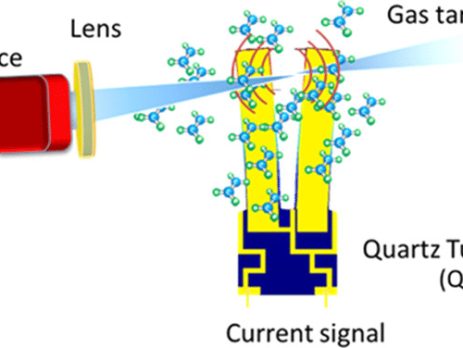Gas Detection Using Enrichment-Enhanced Photoacoustic Spectroscopy
In a recent article published in Sensors and Actuators B: Chemical, researchers introduced an innovative method called enrichment-enhanced photoacoustic spectroscopy (PAS). This technique improves the gas detection sensitivity of PAS by using vertical graphene (VG) as an enrichment material.
The study explored VG’s potential to improve the detection limit of nitric oxide (NO) in gas mixtures, aiming to create a more sensitive and accurate system for air pollution monitoring and non-invasive medical diagnosis.
Background
Gas detection is critical for air quality monitoring, environmental protection, industrial safety, and medical diagnosis. Among traditional gas detection methods, such as electrochemical sensors, semiconductor sensors, gas chromatography, and optical techniques, optical methods are getting attention due to their high sensitivity, quick response, and real-time capabilities.
PAS is a widely used optical technique for detecting gases. It measures sound waves produced when modulated light is absorbed by gas molecules. The strength of the PAS signal depends on both the light power and gas concentration.
However, boosting light power can lead to detector saturation or damage, and increasing gas concentration may be impractical. Therefore, enhancing gas concentration before it reaches the PAS sensor is essential for improving detection sensitivity.
About the Research
The authors proposed a novel method utilizing VG as an enrichment material to enhance the concentration of gas samples before they reach the PAS sensor. VG consists of graphene nanosheets oriented perpendicularly to a substrate, forming a dense, forest-like structure. VG’s large surface area and high chemical reactivity make it suitable for absorbing and desorbing gas molecules.
The researchers designed an enrichment cell with VG and integrated it with a PAS sensor specifically for NO detection, a harmful gas that can cause air pollution and various diseases.
The enrichment cell was equipped with a heating system and valves to control gas flow and operated through three phases: refresh, enrichment, and measuring. During the refresh phase, VG adsorbed NO molecules from a gas mixture. In the enrichment phase, the VG was heated to 150 °C to release NO, increasing its concentration in the cell. In the measuring phase, this enriched gas mixture was sent to the PAS sensor for detection.
For the PAS sensor, the study employed a distributed feedback quantum cascade laser (DFB-QCL) with a wavelength of 5263 nm as the excitation light source. This laser was precisely tuned to the NO absorption line at 1900.08 cm⁻¹.
Using the 2f wavelength modulation spectroscopy (2f-WMS) technique, the researchers reconstructed the NO absorption line and demodulated the PAS signal. The differential photoacoustic cell, equipped with two microphones, measured the resulting sound waves.
Research Findings
The authors optimized the laser current’s modulation depth to maximize the PAS signal. They found that the optimal modulation depth was 14 mA. They also tested the repeatability and consistency of the enrichment process by conducting three measurements under identical conditions. During the measuring phase, the PAS signal increased compared to the refresh and enrichment phases, demonstrating the enrichment method’s effectiveness.
To evaluate the sensor’s performance, the researchers assessed the PAS sensor’s linearity and sensitivity with and without enrichment. They used a gas dilution system to prepare various NO concentrations ranging from 0 to 1000 parts per billion (ppb).
The results showed a linear relationship between the PAS signal and NO concentration in both scenarios. However, with the enrichment method, the sensor’s sensitivity improved by an order of magnitude. The minimum detection limit of the PAS sensor was 14 ppb without enrichment and 1.3 ppb with enrichment, a record value for NO detection using PAS-based techniques.
Applications
The proposed enrichment-enhanced PAS method can be extended to detect other trace gasses that VG can adsorb and desorb, such as carbon monoxide, hydrogen sulfide, ammonia, and volatile organic compounds.
Additionally, this method can be integrated with other PAS-based techniques, like quartz-enhanced PAS and cantilever-enhanced PAS, to further enhance detection performance.
This versatile approach holds potential for various fields requiring high-sensitivity gas detection, including environmental monitoring, industrial process control, biomedical diagnosis, and security.
Conclusion
In summary, the novel approach of using VG significantly enhanced the detection sensitivity of PAS, achieving a detection limit of 1.3 ppb. This method is simple, robust, and versatile, with potential applications for detecting various gas species and integrating with other PAS-based techniques.
The authors suggested further optimizing the enrichment cell design and the heating system to expand its use for detecting additional gasses.
